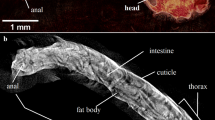Abstract
RECENT investigations concerned with the nutrition of culicine larvæ have shown that there is a marked improvement in the growth rate when protein in suspension replaces protein in solution in the medium1. Whatever the final explanation of this phenomenon, a question arises concerning the ability of this larva to filter and use particulate matter from its environment, swallowing very little water in the process. The larvæ of Anopheles species, which, in Nature, consume large quantities of suspended material in the form of micro-organisms, might also be suspected of being able to perform this task. To examine this possibility, an attempt has been made to determine the rate of equilibration of a small, highly soluble molecule between the surrounding medium and the gut of the fourth instar larva of Anopheles quadrimaculatus Say.
This is a preview of subscription content, access via your institution
Access options
Subscribe to this journal
Receive 51 print issues and online access
$199.00 per year
only $3.90 per issue
Buy this article
- Purchase on Springer Link
- Instant access to full article PDF
Prices may be subject to local taxes which are calculated during checkout
Similar content being viewed by others
References
Akov, S., J. Insect. Physiol., 8, 319 (1962).
Author information
Authors and Affiliations
Rights and permissions
About this article
Cite this article
FRIEDMAN, S. Rate of Equilibration of the Contents of the Gut of Anopheles quadrimaculatus Larvæ with the Surrounding Medium. Nature 200, 605–606 (1963). https://doi.org/10.1038/200605a0
Issue Date:
DOI: https://doi.org/10.1038/200605a0
Comments
By submitting a comment you agree to abide by our Terms and Community Guidelines. If you find something abusive or that does not comply with our terms or guidelines please flag it as inappropriate.



